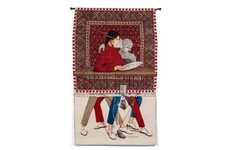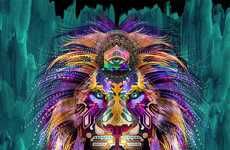
Shirly Raz Illustrates Images that Toy with Viewers' Eyes
Jason Soy — June 21, 2012 — Art & Design
References: saatchionline & artforadults.tumblr
It’s perfectly normal to think of optical illusion books or Beetlejuice when gazing upon a Shirly Raz rendering. After all, the well-traveled artist often incorporates black and white stripes into her work and they’re famously associated with the two aforementioned things. Much more impressive though are the inventive ways she weaves stripes onto people’s bodies and surroundings. Her resulting images are the definition of surreal, with faces seemingly disappearing into a floor and women blending harmoniously into hypnotic spirals. You just know you’re in for a visual treat when browsing her work.
Though she has many years of art education under her belt, Shirly Raz is still currently enrolled at the Russian Academy of Art in Florence. Prior to that, she was at the Angel Academy of Art, mastered her craft under the tutelage of George Roth and spent seven years studying art in Israel.
Though she has many years of art education under her belt, Shirly Raz is still currently enrolled at the Russian Academy of Art in Florence. Prior to that, she was at the Angel Academy of Art, mastered her craft under the tutelage of George Roth and spent seven years studying art in Israel.
Trend Themes
1. Optical Illusion Art - There is a disruptive innovation opportunity to revolutionize the art industry by creating visually stunning and mind-bending optical illusion artworks.
2. Surreal Imagery - There is a disruptive innovation opportunity to explore the use of surreal imagery in various industries, such as advertising and digital media, to captivate and engage audiences.
3. Interactive Visual Experiences - There is a disruptive innovation opportunity to develop immersive and interactive visual experiences using techniques like incorporating stripes and illusions into physical spaces or virtual reality environments.
Industry Implications
1. Art - The art industry can leverage optical illusion techniques and surreal imagery to create unique and thought-provoking artworks that push the boundaries of perception.
2. Advertising - The advertising industry can utilize optical illusion art and surreal imagery in campaigns to create impactful and memorable visual experiences that grab viewers' attention.
3. Design - The design industry can explore incorporating optical illusion elements and surreal imagery into products, spaces, and user interfaces to enhance user experiences and evoke emotional responses.
3.3
Score
Popularity
Activity
Freshness























